Hongkyu Yoon
Efficient machine-learning surrogates for large-scale geological carbon and energy storage
Oct 11, 2023Abstract:Geological carbon and energy storage are pivotal for achieving net-zero carbon emissions and addressing climate change. However, they face uncertainties due to geological factors and operational limitations, resulting in possibilities of induced seismic events or groundwater contamination. To overcome these challenges, we propose a specialized machine-learning (ML) model to manage extensive reservoir models efficiently. While ML approaches hold promise for geological carbon storage, the substantial computational resources required for large-scale analysis are the obstacle. We've developed a method to reduce the training cost for deep neural operator models, using domain decomposition and a topology embedder to link spatio-temporal points. This approach allows accurate predictions within the model's domain, even for untrained data, enhancing ML efficiency for large-scale geological storage applications.
Subsurface Characterization using Ensemble-based Approaches with Deep Generative Models
Oct 10, 2023Abstract:Estimating spatially distributed properties such as hydraulic conductivity (K) from available sparse measurements is a great challenge in subsurface characterization. However, the use of inverse modeling is limited for ill-posed, high-dimensional applications due to computational costs and poor prediction accuracy with sparse datasets. In this paper, we combine Wasserstein Generative Adversarial Network with Gradient Penalty (WGAN-GP), a deep generative model that can accurately capture complex subsurface structure, and Ensemble Smoother with Multiple Data Assimilation (ES-MDA), an ensemble-based inversion method, for accurate and accelerated subsurface characterization. WGAN-GP is trained to generate high-dimensional K fields from a low-dimensional latent space and ES-MDA then updates the latent variables by assimilating available measurements. Several subsurface examples are used to evaluate the accuracy and efficiency of the proposed method and the main features of the unknown K fields are characterized accurately with reliable uncertainty quantification. Furthermore, the estimation performance is compared with a widely-used variational, i.e., optimization-based, inversion approach, and the proposed approach outperforms the variational inversion method, especially for the channelized and fractured field examples. We explain such superior performance by visualizing the objective function in the latent space: because of nonlinear and aggressive dimension reduction via generative modeling, the objective function surface becomes extremely complex while the ensemble approximation can smooth out the multi-modal surface during the minimization. This suggests that the ensemble-based approach works well over the variational approach when combined with deep generative models at the cost of forward model runs unless convergence-ensuring modifications are implemented in the variational inversion.
Progressive reduced order modeling: empowering data-driven modeling with selective knowledge transfer
Oct 04, 2023Abstract:Data-driven modeling can suffer from a constant demand for data, leading to reduced accuracy and impractical for engineering applications due to the high cost and scarcity of information. To address this challenge, we propose a progressive reduced order modeling framework that minimizes data cravings and enhances data-driven modeling's practicality. Our approach selectively transfers knowledge from previously trained models through gates, similar to how humans selectively use valuable knowledge while ignoring unuseful information. By filtering relevant information from previous models, we can create a surrogate model with minimal turnaround time and a smaller training set that can still achieve high accuracy. We have tested our framework in several cases, including transport in porous media, gravity-driven flow, and finite deformation in hyperelastic materials. Our results illustrate that retaining information from previous models and utilizing a valuable portion of that knowledge can significantly improve the accuracy of the current model. We have demonstrated the importance of progressive knowledge transfer and its impact on model accuracy with reduced training samples. For instance, our framework with four parent models outperforms the no-parent counterpart trained on data nine times larger. Our research unlocks data-driven modeling's potential for practical engineering applications by mitigating the data scarcity issue. Our proposed framework is a significant step toward more efficient and cost-effective data-driven modeling, fostering advancements across various fields.
Reduced order modeling with Barlow Twins self-supervised learning: Navigating the space between linear and nonlinear solution manifolds
Feb 11, 2022


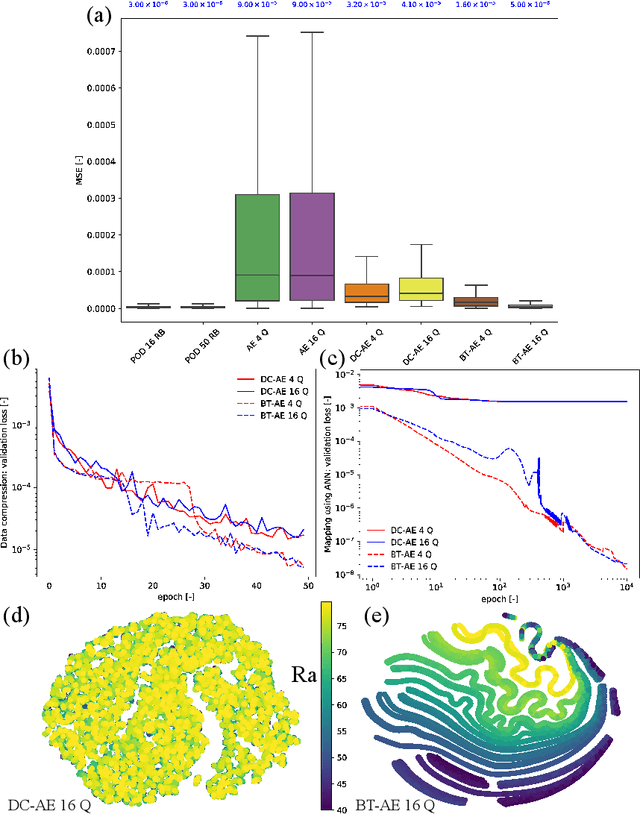
Abstract:We propose a unified data-driven reduced order model (ROM) that bridges the performance gap between linear and nonlinear manifold approaches. Deep learning ROM (DL-ROM) using deep-convolutional autoencoders (DC-AE) has been shown to capture nonlinear solution manifolds but fails to perform adequately when linear subspace approaches such as proper orthogonal decomposition (POD) would be optimal. Besides, most DL-ROM models rely on convolutional layers, which might limit its application to only a structured mesh. The proposed framework in this study relies on the combination of an autoencoder (AE) and Barlow Twins (BT) self-supervised learning, where BT maximizes the information content of the embedding with the latent space through a joint embedding architecture. Through a series of benchmark problems of natural convection in porous media, BT-AE performs better than the previous DL-ROM framework by providing comparable results to POD-based approaches for problems where the solution lies within a linear subspace as well as DL-ROM autoencoder-based techniques where the solution lies on a nonlinear manifold; consequently, bridges the gap between linear and nonlinear reduced manifolds. Furthermore, this BT-AE framework can operate on unstructured meshes, which provides flexibility in its application to standard numerical solvers, on-site measurements, experimental data, or a combination of these sources.
Machine Learning in Heterogeneous Porous Materials
Feb 04, 2022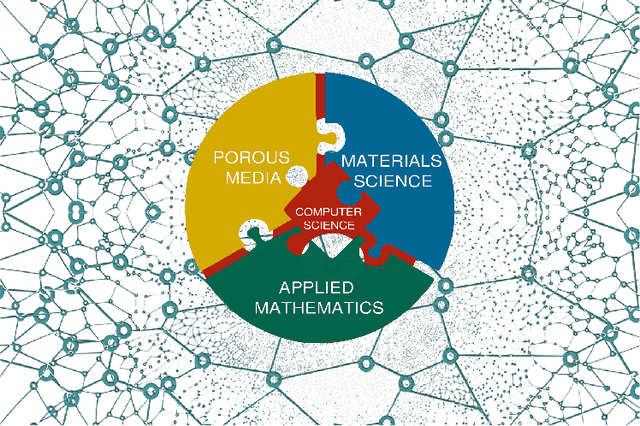
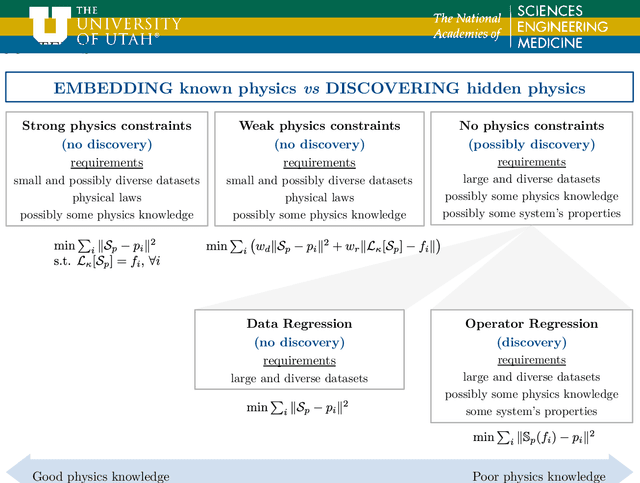
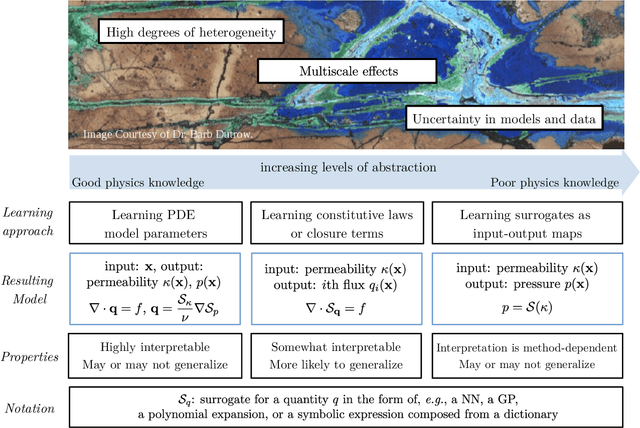

Abstract:The "Workshop on Machine learning in heterogeneous porous materials" brought together international scientific communities of applied mathematics, porous media, and material sciences with experts in the areas of heterogeneous materials, machine learning (ML) and applied mathematics to identify how ML can advance materials research. Within the scope of ML and materials research, the goal of the workshop was to discuss the state-of-the-art in each community, promote crosstalk and accelerate multi-disciplinary collaborative research, and identify challenges and opportunities. As the end result, four topic areas were identified: ML in predicting materials properties, and discovery and design of novel materials, ML in porous and fractured media and time-dependent phenomena, Multi-scale modeling in heterogeneous porous materials via ML, and Discovery of materials constitutive laws and new governing equations. This workshop was part of the AmeriMech Symposium series sponsored by the National Academies of Sciences, Engineering and Medicine and the U.S. National Committee on Theoretical and Applied Mechanics.
Neurodynamical Role of STDP in Storage and Retrieval of Associative Information
Apr 25, 2021



Abstract:Spike-timing-dependent plasticity (STDP) is a biological process in which the precise order and timing of neuronal spikes affect the degree of synaptic modification. While there has been numerous research focusing on the role of STDP in neural coding, the functional implications of STDP at the macroscopic level in the brain have not been fully explored yet. In this work, we propose that STDP in an ensemble of spiking neurons renders storing high dimensional information in the form of a `memory plane'. Neural activity based on STDP transforms periodic spatio-temporal input patterns into the corresponding memory plane, where the stored information can be dynamically revived with a proper cue. Using the dynamical systems theory that shows the analytic relation between the input and the memory plane, we were able to demonstrate a specific memory process for high-dimensional associative data sets. In the auto-associative memory task, a group of images that were continuously streamed to the system can be retrieved from the oscillating neural state. The second application deals with the process of semantic memory components that are embedded from sentences. The results show that words can recall multiple sentences simultaneously or one exclusively, depending on their grammatical relations. This implies that the proposed framework is apt to process multiple groups of associative memories with a composite structure.
Applications of physics-informed scientific machine learning in subsurface science: A survey
Apr 13, 2021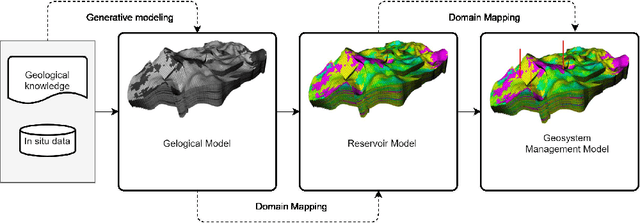
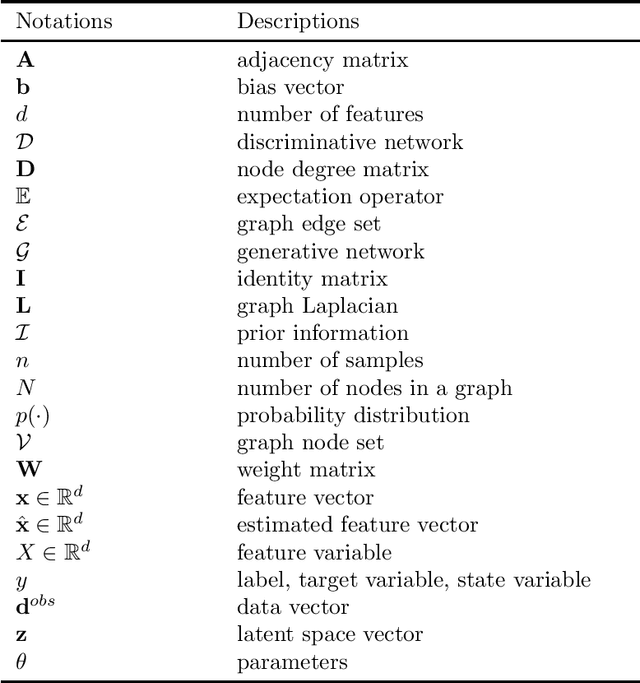
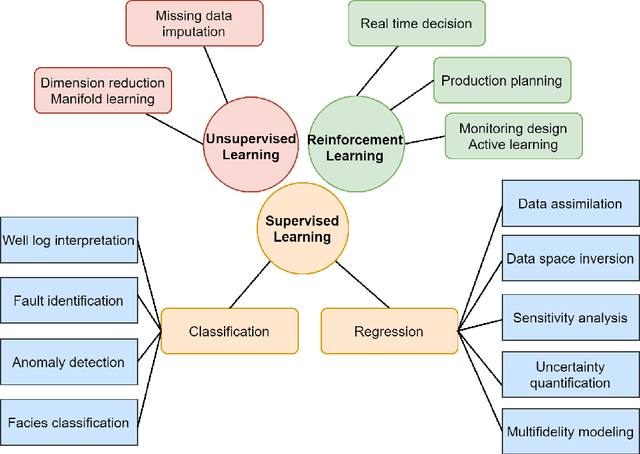
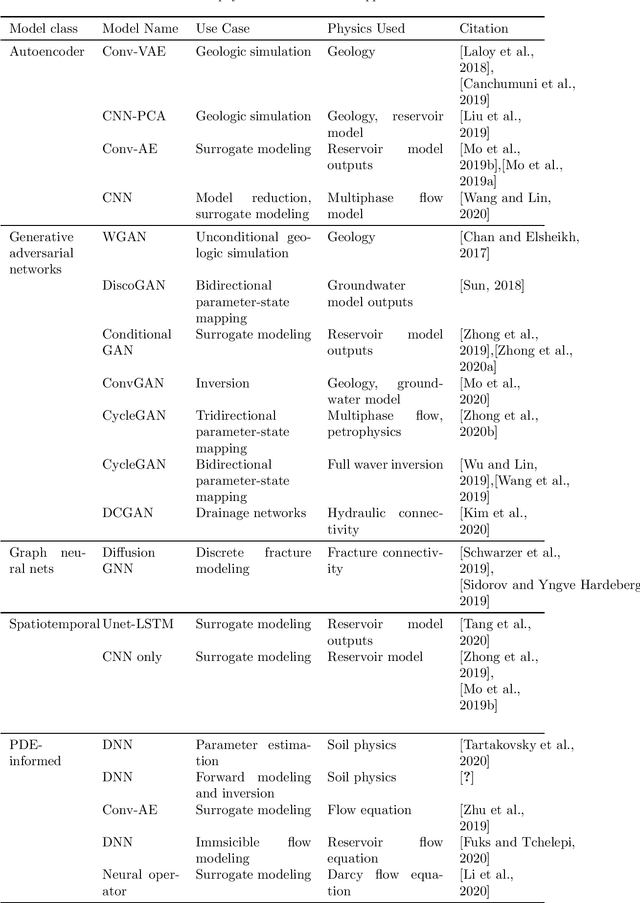
Abstract:Geosystems are geological formations altered by humans activities such as fossil energy exploration, waste disposal, geologic carbon sequestration, and renewable energy generation. Geosystems also represent a critical link in the global water-energy nexus, providing both the source and buffering mechanisms for enabling societal adaptation to climate variability and change. The responsible use and exploration of geosystems are thus critical to the geosystem governance, which in turn depends on the efficient monitoring, risk assessment, and decision support tools for practical implementation. Fast advances in machine learning (ML) algorithms and novel sensing technologies in recent years have presented new opportunities for the subsurface research community to improve the efficacy and transparency of geosystem governance. Although recent studies have shown the great promise of scientific ML (SciML) models, questions remain on how to best leverage ML in the management of geosystems, which are typified by multiscality, high-dimensionality, and data resolution inhomogeneity. This survey will provide a systematic review of the recent development and applications of domain-aware SciML in geosystem researches, with an emphasis on how the accuracy, interpretability, scalability, defensibility, and generalization skill of ML approaches can be improved to better serve the geoscientific community.
Fast and Scalable Earth Texture Synthesis using Spatially Assembled Generative Adversarial Neural Networks
Nov 13, 2020
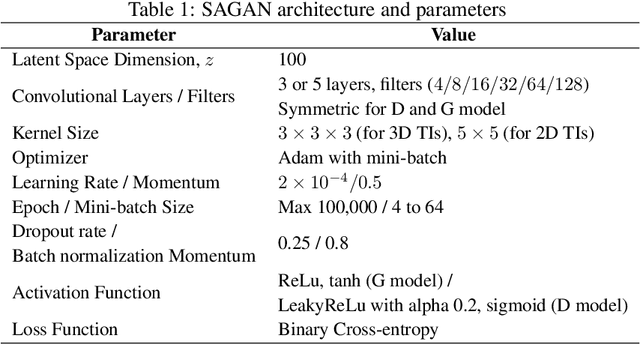


Abstract:The earth texture with complex morphological geometry and compositions such as shale and carbonate rocks, is typically characterized with sparse field samples because of an expensive and time-consuming characterization process. Accordingly, generating arbitrary large size of the geological texture with similar topological structures at a low computation cost has become one of the key tasks for realistic geomaterial reconstruction. Recently, generative adversarial neural networks (GANs) have demonstrated a potential of synthesizing input textural images and creating equiprobable geomaterial images. However, the texture synthesis with the GANs framework is often limited by the computational cost and scalability of the output texture size. In this study, we proposed a spatially assembled GANs (SAGANs) that can generate output images of an arbitrary large size regardless of the size of training images with computational efficiency. The performance of the SAGANs was evaluated with two and three dimensional (2D and 3D) rock image samples widely used in geostatistical reconstruction of the earth texture. We demonstrate SAGANs can generate the arbitrary large size of statistical realizations with connectivity and structural properties similar to training images, and also can generate a variety of realizations even on a single training image. In addition, the computational time was significantly improved compared to standard GANs frameworks.
Connectivity-informed Drainage Network Generation using Deep Convolution Generative Adversarial Networks
Jun 16, 2020



Abstract:Stochastic network modeling is often limited by high computational costs to generate a large number of networks enough for meaningful statistical evaluation. In this study, Deep Convolutional Generative Adversarial Networks (DCGANs) were applied to quickly reproduce drainage networks from the already generated network samples without repetitive long modeling of the stochastic network model, Gibb's model. In particular, we developed a novel connectivity-informed method that converts the drainage network images to the directional information of flow on each node of the drainage network, and then transform it into multiple binary layers where the connectivity constraints between nodes in the drainage network are stored. DCGANs trained with three different types of training samples were compared; 1) original drainage network images, 2) their corresponding directional information only, and 3) the connectivity-informed directional information. Comparison of generated images demonstrated that the novel connectivity-informed method outperformed the other two methods by training DCGANs more effectively and better reproducing accurate drainage networks due to its compact representation of the network complexity and connectivity. This work highlights that DCGANs can be applicable for high contrast images common in earth and material sciences where the network, fractures, and other high contrast features are important.
 Add to Chrome
Add to Chrome Add to Firefox
Add to Firefox Add to Edge
Add to Edge